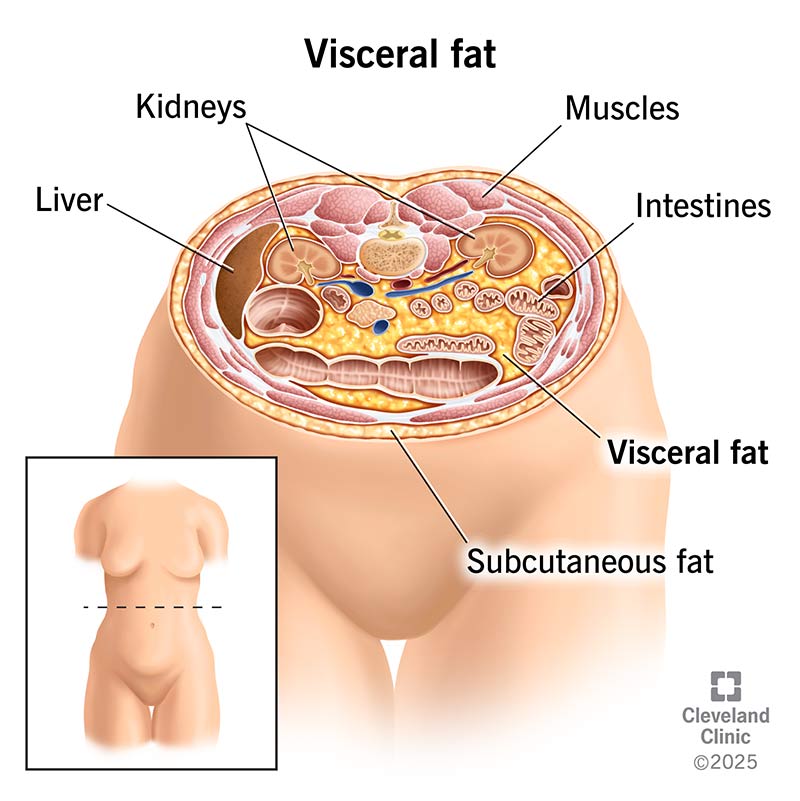Visceral fat is something that everyone has. It’s a layer of soft, cushioning protection around several of your internal organs. It also has a role in how your body stores and uses energy. But you can have too much of this good thing. And having too much may increase your risk of health problems.
Advertisement
Cleveland Clinic is a non-profit academic medical center. Advertising on our site helps support our mission. We do not endorse non-Cleveland Clinic products or services. Policy

Visceral fat is a type of body fat you have deeper inside you. It gets its name from its location. Viscera is a term for internal organs and tissues. Visceral fat lines your abdominal walls and wraps around many of your internal organs.
Advertisement
Cleveland Clinic is a non-profit academic medical center. Advertising on our site helps support our mission. We do not endorse non-Cleveland Clinic products or services. Policy
Visceral fat is sometimes called “active fat” because it plays an active role in how your body functions. Having some visceral fat is normal and healthy. It cushions and protects your internal organs. But having too much visceral fat may be harmful. Research links having too much visceral fat to a higher risk of cardiovascular disease.
Visceral fat cushions or surrounds several internal organs, including your:
Belly fat includes both visceral and subcutaneous fat.
Visceral fat consists of adipocytes, or fat cells. The adipocytes in visceral fat are sensitive to hormones, chemical messenger molecules that your body uses. That can affect the way your body uses (metabolizes) and stores fat.
Metabolic syndrome conditions like diabetes often change how your body handles hormone signals. That might explain why having more visceral fat raises your risk of having cardiovascular disease.
Everyone has some amount of visceral fat. Genetics contribute to how much you have and where it is in your body. That’s part of what determines your body’s shape.
But environmental factors and your choices also influence how much visceral fat you have. For example, eating fatty foods and carbohydrates (sugars) can make your body form more visceral fat. And if you aren’t active enough, you’ll make more visceral fat than your body uses for energy.
Advertisement
While you might not realize it, stress can also play a role in visceral fat. One hormone that can affect visceral fat adipocytes is the stress hormone cortisol. It makes your body add to its store of visceral fat.
The most common conditions that affect visceral fat are obesity and related issues, including:
But certain endocrine system diseases can also affect visceral fat. Most of these aren’t common, but they can be very serious. Examples include:
The main indications of an issue affecting visceral fat are:
Since you can’t see or feel visceral fat, you have to rely on other ways to keep tabs on it. Your body shape and measurements are the best indicators of how much you have and if the amount changes.
The normal visceral fat range should be about 10% of your body fat. You can figure out your visceral fat level by calculating your total body fat percentage and then taking off 10%. If you have a higher body fat percentage than recommended, your visceral fat range will be higher, too.
There are a few ways you can check your body fat distribution:
Taking these measurements and making sense of them by yourself can be tricky. If you have questions about your measurements or what they mean, there’s someone who can help. Talk to your primary care provider. They can answer your questions and offer guidance.
Advertisement
Maintaining a healthy lifestyle is the best way to lose visceral fat. You can lower your visceral fat level using the same methods that help you lose weight and lower your total body fat. For instance:
No, visceral fat is actually easier to lose than subcutaneous fat. If you’re consistent with staying active and managing what you eat, you can start to see fat loss in two to three months.
Advertisement
Visceral fat is something that everyone has. It’s normal, healthy and part of how your body develops and works. But having too much visceral fat isn’t a good thing.
If you have questions or concerns about visceral fat and how it might be affecting you, you should talk to your primary care provider. They can help you understand your situation and what you can do about it.
Advertisement
Cleveland Clinic’s primary care providers offer lifelong medical care. From sinus infections and high blood pressure to preventive screening, we’re here for you.

Last reviewed on 08/22/2025.
Learn more about the Health Library and our editorial process.